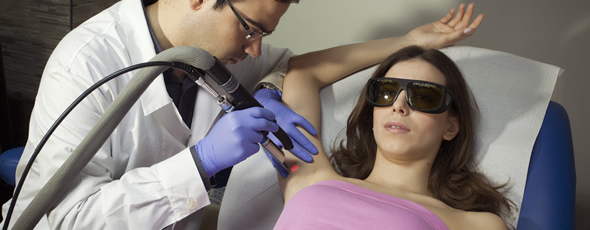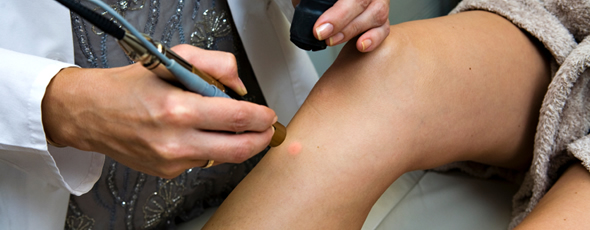The laser is a machine that produces light that is selectively absorbed by the melanin of the hair bulb (root)
Laser hair removal is the most effective method for the gradual permanent reduction and even disappearance of hair growth. It is preferred by both women and men, mainly thanks to the fact that it is safe, fast and painless, while its results are truly impressive.
The laser is a machine that produces light that is selectively absorbed by the melanin of the bulb (root) of the hair, as a result of which it achieves a selective focus of energy on the hair which is destroyed without affecting the epidermis (which is protected through dynamic cooling). It is important to separate laser technology (and we believe that Alexandrite is the most effective laser for hair removal) from other technologies that use light for hair removal, such as pulsed light or IPL or photolysis.
Laser hair removal can be applied to any area of the body where there is unwanted hair growth such as:
- Face (upper lip, chin, cheeks, sideburns, eyebrows, etc.)
- Hands (whole or forearms), armpits
- Bikini, legs (full / calves or thighs only), buttocks
- Waist (waist) and back (men - women)
- Chest (men - women)
- Belly line etc.
There is no risk for the tissues and organs located under the skin (e.g. lymph nodes, ovaries, etc.) because the laser has a certain depth of penetration (which is determined by the wavelength it has) and for Alexandrite it does not even reach the subcutaneous fat, so it is completely safe.
Laser hair removal is mainly done for aesthetic reasons, however, there are also cases, such as e.g. women who develop recurrent folliculitis ("pimples with pus") after waxing or shaving. In these cases, the laser is the most appropriate medical treatment of the problem.
The number of sessions that will be needed depends mainly on the phototype of the patient (the color of the skin in relation to the color of the hair), on the previous methods of hair removal that have been used, on the age of the patient, and above all on the possible coexistence of someone endocrine-hormonal problem. So we cannot predict with absolute precision how many sessions each patient will need, but in general we can talk about an average of 5 sessions (with as many repeat sessions every 15-20 days which are free).
[blockquote]For laser treatment, there is a free appointment to take a history (hormonal testing may also be required before the start of treatment), evaluate hair growth and inform and resolve any questions about laser hair removal.[/ blockquote]

"Laser hair removal is the safest and most effective way to permanently remove unwanted hair. We should not confuse the laser with other methods such as photo hair removal, pulsed light, i.e. IPL, because the laser is exclusively designed to do this job and it does it very well. 5 sessions and their repetitions are required to remove unwanted hair growth from the respective area. We recommend the Alexandrite laser as the best for this treatment and specifically the LPX of the American giant LightAge. It is the company that has discovered Alexandrite and has the best results in the shortest time. In particular, we can epilate the entire leg in just 20 minutes, the same for a man's back and this is very important for the patient who respects his time. There is no contraindication, people should not worry, because the laser does not reach below 2/3 of the skin so it cannot damage internal organs or lymph nodes and it is completely safe to do at any age."
Who are suitable for laser hair removal?
Both women and men seek laser hair removal to remove unwanted hair. The application can be done on the face, armpits, bikini, buttocks, legs, abdomen, waist, back. The laser targets the skin pigment (melanin) so the ideal combination for hair removal is a person with light skin color and dark hair color
How does laser hair removal work? What role does hair color play?
The laser targets the skin's pigment (melanin), so treatments are most effective on dark and thick hair that contains a large amount of pigment. Fine hair and fluff absorb the heat produced by the laser more difficult. Also, blonde hairs that contain less pigment will need more treatment sessions to ensure a permanent hair removal result. Finally, at older ages where the hairs have completely lost their color (gray or white) it is not possible to treat them with the help of the laser.
Is there a difference between IPL (photolysis) and LASER technologies in hair removal?
These are two completely different technologies. IPL (photolysis) produces a wide range of light which also heats the surrounding tissues, so the result in terms of hair removal is poorer, while the patient (especially if he has dark skin) is at a greater risk of suffering a burn from the application. IPL devices are cheaper than the corresponding lasers, while a doctor is not required to perform the application, and for this reason they have found great popularity in the various aesthetic institutes. In conclusion, specialized lasers for hair removal (Alexandrite, Diodika, NdYag) achieve better and faster results than photolysis.
How many laser sessions will I need and what is the interval between sessions?
Most patients need at least 5-6 sessions spaced approximately 4 weeks apart. Each session is accompanied by a repeat session which takes place after 15-20 days from the initial session and which it complements and perfects. The exact number of sessions needed depends on the contrast between the patient's skin color and their hair color. The lighter the skin and the darker the hair, the fewer sessions will be needed.
Is laser hair removal painful?
No. The application is made with simultaneous very strong cooling of the area (with cold air). This cooling guarantees safety for the treatment and painless treatment. Only a small percentage of patients resort to the use of anesthetic cream (EMLA) only for the bikini area, which is considered the most sensitive to pain.
What are the possible side effects of laser hair removal?
The only side effect seen is a little redness and the formation of small bumps (bumps of skin right where the hair follicle openings are on the skin) which can be mildly itchy. These are fully reversible and only last for a few hours after treatment. Essentially, this is not an unwanted effect but the result of the "explosion" of the hair bulb (root), with the effect of the laser, inside the skin (it means that we have achieved effective hair removal!). They are easily treated by applying a moisturizing anti-inflammatory cream to the skin after application.
How can I achieve with the help of the laser the reduction (but not the disappearance) of the density of hair growth in an area?
This can be achieved if we stop the laser treatment at the 3 applications (and the same number of repeated sessions) instead of 5-6 sessions which are required for the complete disappearance of the hairs.
What preparation should I do before applying the laser for hair removal?
It must not be preceded by any depilatory method that removes the hair for a period of one month before the application of the laser. This is because if a wax or silkepil is used before the application of the laser, they uproot the hair along with its root, so the laser will not be able to target the root of the hair and achieve its effective destruction. For the same reason, it is not allowed to use wax during the entire time we are doing laser hair removal (in between applications we can use a razor if this is necessary).
Also, the area to be depilated must be shaved (or the facial hair cut with scissors) 2-3 days before the application of the laser. This ensures that the energy of the laser will be utilized exactly where it should be (ie at the root of the hair) and not at the hair shaft (the part of the hair that protrudes above the skin). Also, if the laser "hits" the hair shaft, it will melt and create a burn mark on the surface of the skin, which is also undesirable.
As a conclusion, we must shave the area 2-3 days before each application, and avoid for the entire duration of the laser treatment hair removal methods that remove the hair.
What are the reasons for excessive hair growth (hypertrichosis) that must be investigated before starting laser treatment?
Excessive hair growth can be due to heredity, endocrinological (hormonal) disorders such as polycystic ovary syndrome and insulin resistance, thyroid problems. But it can also be due to specific medication treatments that we have started, to the normal aging process as well as excessive use of depilatory methods which affect the root of the hair.
Usually before we start the laser treatment we do an investigation (laboratory check with blood tests, gynecological ultrasound) for the pathological causes of hirsutism especially when there is excessive hair growth or when there is hair growth in areas that should not be there (in the jaw-chin area in women or below the navel in women etc.)
[gravityform id=”4″ name=”More Info” title=”false” ajax=”true”][/tab]


